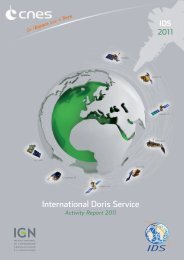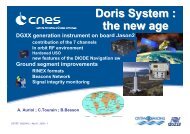ALTIKA : A MICRO-SATELLITE Ka-BAND ALTIMETRY MISSION
ALTIKA : A MICRO-SATELLITE Ka-BAND ALTIMETRY MISSION
ALTIKA : A MICRO-SATELLITE Ka-BAND ALTIMETRY MISSION
You also want an ePaper? Increase the reach of your titles
YUMPU automatically turns print PDFs into web optimized ePapers that Google loves.
nominal tracking conditions (about 3 km alongtrack).These values will be associated with small footprintsfor the radiometer as well since altimeter andradiometer will share the same antenna. In additionto the altitude reduction, which is the maincontributor to the radiometerfootprint reduction, it may also be noticed that theabsence of an additional 19-GHz channel to theradiometer is also an advantage since this lowfrequency would give the largest footprint.POSEI--DON2(Ku-band)POSEI--DON2 (Cband)Alti<strong>Ka</strong> (800km)Alti<strong>Ka</strong> (500km)Leadingedge(2-mSWH)128-gateecho(2-mSWH)Footprintdiameter at3-dBattenuation5.3 19.1 19.55.3 19.1 49.54.1 12.7 7.23.4 10.3 4.6Table : Footprint diameter for different criteria(values given for a 75-cm antenna for Alti<strong>Ka</strong>)This is why it is expected that Alti<strong>Ka</strong> will give usefuldata as close as 5 km from a majority of coastalareas. Associated with a shorter data cycle (probably500 ms instead of 1 s), it will probably represent amajor improvement in mesoscale and coastalapplications of radar altimetry.3.3. Minimizing penetration effects overcontinental iceAn empirical analysis of the temporal variability ofthe satellite radar altimetric observationdemonstrates that the Ku-band radar penetrationabove the dry snowpack of Antarctica is between 5m in the interior to 14 m at a lower altitude, beforedecreasing due to wetness near the coast. Theabsorption coefficient of dry snow being 0.05 m -1 , itinduces a scattering coefficient comprised between0.05 and 0.16 m -1 , depending on ice the grain sizewhich varies from 0.2 to 3 mm.In <strong>Ka</strong>-band, Mie scattering can be assumed, then thescattering coefficient is inversely proportional to theradar wavelength at a power 4. From Ku to <strong>Ka</strong>bands, the scattering coefficient will increase by afactor 55: the volume scattering will then be clearlydominant over the surface scattering. Inversely, theradar wave extinction will also increase to valuescomprised between 2.75 and 8.75 m -1 , leading to apenetration depth over snow surface between 0.3 and0.1 m. The altimetric observation and heightrestitution will thus correspond to a thin subsurfacelayer. The accuracy will then be considerablyimproved.Moreover, ice grain size, that is one of the pertinentclimatological snow parameters, could be directlyderived from <strong>Ka</strong>-band scattering coefficient, whichis not possible from present day Ku measurementsthat also highly depend on surface roughness.However, the major benefit will lie in the reductionof the induced long term bias due to the temporalchange in the snowpack surface. Indeed, a strongtemporal variability of the altimetric observationsover Antarctica ice sheet has been recently exhibitedwith the help of the ERS-1 three day orbit mission.These temporal variations are linked tometeorological events and consequently play a roleon a large band of the temporal spectrum, from fewhours to few decades. They are due to changes insurface roughness induced by change in wind, whichmodifies the echo surface part and then, both thewaveform shape and the elevation recovery. Evenwith a dedicated correction, the residual correctionyields to a raw noise estimate of 10 cm.3.4. Propagation losses3.4.1. Attenuation effectsIt is known that propagation of EHF waves throughthe troposphere may suffer from severe attenuationdue to the interaction of the electromagnetic wavewith the atmospheric contents. As far as the <strong>Ka</strong>-bandaltimeter is concerned, current requirement is thatthe instrument provides nominal performance 90%of time, with an objective as high as 95%. Anextensive study has been made to analyze thecontributions from :(i) gazes : attenuation is calculated for oxygen andwater vapour. Even if the allocated frequency rangeis nearly ideally chosen with respect to the waterpropagation spectral window, strong attenuation mayresult from moderate to high humidity contents.Values may vary from 0.4 to 2.1 dB when humidityvaries from 7.5 to 50 g/m3.(ii) clouds : 7 types of clouds are taken into accountfor the propagation models. Attenuation is estimatedfrom their liquid vapour contents and depths. Asexpected, cumulus and cumulonimbus are generally






